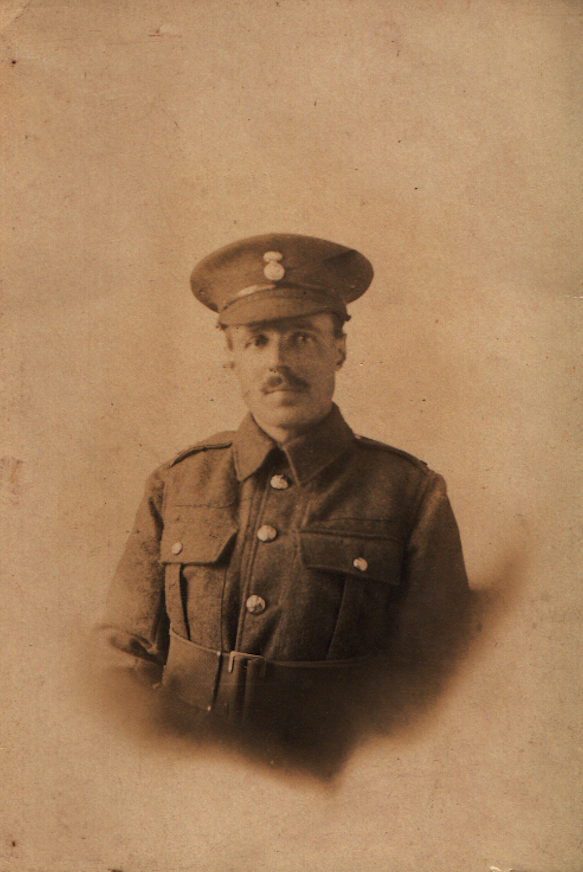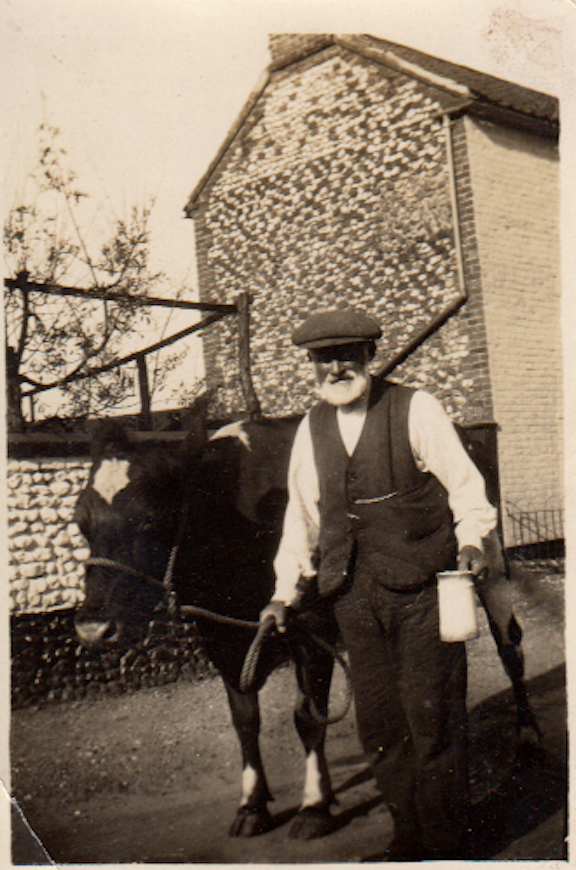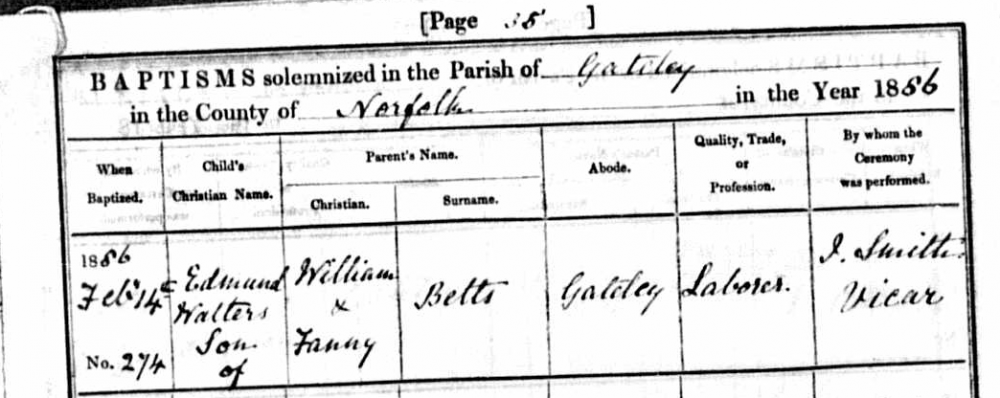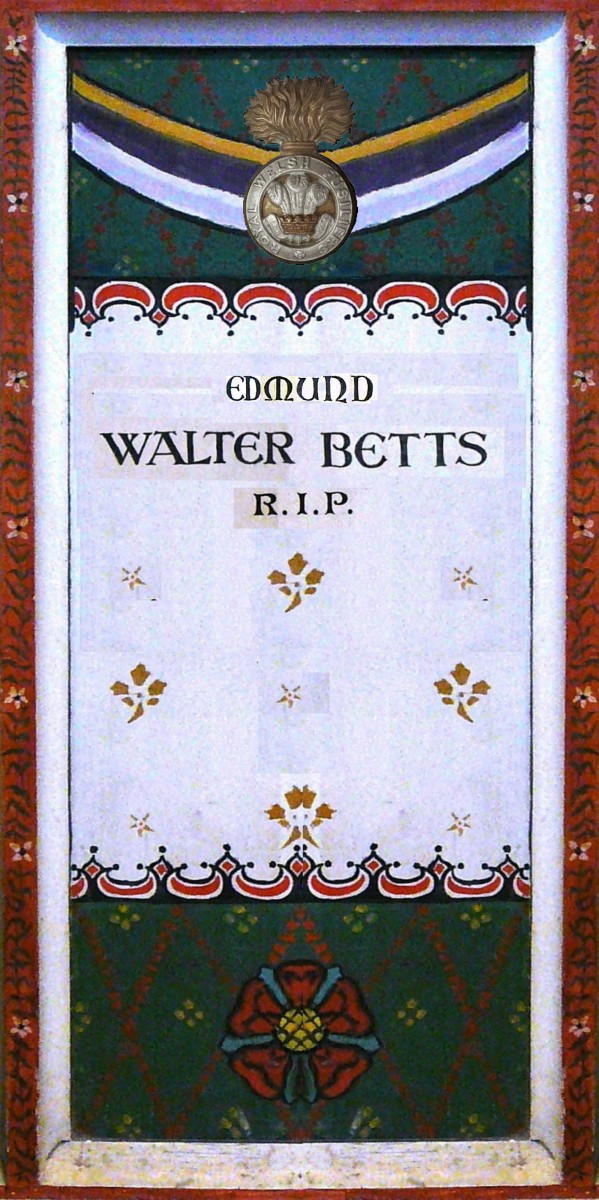Ryburgh Remembers
Pte. 53990 Edmund Walter Betts
19th. Btn. Royal Welch Fusiliers
1886 - November 23rd. 1917



William and Fanny Betts
Walter was the 4th of the 8 children born to William and Fanny Betts. He was born in Gateley and baptised at St Helen’s on Feb 14th 1886:

By the time of the 1901 Census he had left the family home and was in service as a page in Matlaske (possibly Matlaske Hall) boarding with domestic coachman William Ford, his wife Elizabeth and son. He seems to have been destined for the world of domestic service as his next appearance, in the 1911 Census, is as a domestic gardener. Now he was boarding with a widow and her family of 5 in Southbourne near Bournemouth.
Whilst there he courted Elizabeth Mary Curry a Gloucestershire born housemaid working for a household in Bournemouth. They were married on 20th September 1911 at the Church of St John the Baptist in Frenchay Gloucestershire. A daughter, Lillian Mary Fanny Betts was born in the Spring of 1914. The birth was registered in Gloucestershire so it is assumed that Elizabth Mary went to her parental home to give birth. It is not known how long they were to spend together as a family before Walter enlisted. The entry in the Cambrai Memorial Index gives his widow’s address as “Mayfield”, Inverleigh Rd., West Southbourne, Bournemouth.
She still lived in Inverleigh Road ( No 23) when she died, still a widow on May 30th. 1952. She was survived by daughter Lillian.
Walter’s Medal Index card shows that after enlisting, he served with the Welsh Regiment (Pte.51373) before joining the Royal Welch Fusiliers.
Walter Betts died during the assault on BOURLON WOOD which was taken in the early stages of the Battle of Cambrai
The Royal Welch Fusiliers War Diary has a 4 page description of the action followed by the usual tally of casualties. It shows 343 Other Ranks were killed or wounded, Walter among them, with 116 believed to have died at the time the list was compiled
The War Diary continues:
Special Order of the Day by the GOC 119th. Inf. Brigade, as follows:-
“The G.O.C. 119th. Inf. Brigade wishes to congratulate all ranks of the Brigade on the results of their efforts in action on 23rd,24th, & 25th. November 1917.
The valour and endurance displayed was beyond all praise. A most important tactical position in BOURLON WOOD was assaulted and taken on 23rd. And held against countless counter-attacks and ceaseless pressure till handed over , consolidated & intact to 186th Inf. Brigade on the night of 25/26th. November. The enemy attacked up to the last moment of relief.”
Walter’s name is inscribed on Panel No 5 Stone G of the Cambrai Memorial:
"which commemorates more than 7,000 servicemen of the United Kingdom and South Africa who died in the Battle of Cambrai in November and December 1917 and whose graves are not known. Sir Douglas Haig described the object of the Cambrai operations as the gaining of a 'local success by a sudden attack at a point where the enemy did not expect it' and to some extent they succeeded. The proposed method of assault was new, with no preliminary artillery bombardment. Instead, tanks would be used to break through the German wire, with the infantry following under the cover of smoke barrages. The attack began early in the morning of 20 November 1917 and initial advances were remarkable.
However, by 22 November, a halt was called for rest and reorganisation, allowing the Germans to reinforce. From 23 to 28 November, the fighting was concentrated almost entirely around Bourlon Wood and by 29 November, it was clear that the Germans were ready for a major counterattack. During the fierce fighting of the next five days, much of the ground gained in the initial days of the attack was lost. For the Allies, the results of the battle were ultimately disappointing but valuable lessons were learned about new strategies and tactical approaches to fighting. The Germans had also discovered that their fixed lines of defence, no matter how well prepared, were vulnerable.
The above is to be found on:
and the futility of the stalemate situation described there must have been replicated so many times during the course of the War.
As explained on his brother John’s page, Walter was not included on either the Ryburgh Roll of Honour or the Think and Thank Screen although he is inscribed on the Village Obelisk. It was one of the first tasks of the current project to see if the extra names we were finding in the course of our researches could also be included in St Andrew’s. Because we have found so many more soldiers, this now out of date page explains more of this story and explains the facsimile inscription below which currently hangs on Comper’s West Gallery:

We are very grateful to Keith Venables, Walter Betts' Great Nephew for sharing information about his Ryburgh family, and for supplying the wonderful images seen above.
*********
Some 4 years after this page was published we were contacted by Lars Ahlkvist from Sweden who had found us online. He has made his own investigation into this history as a result of acquiring Walter's 2 medals and death plaque. He most kindly offered an image of these items for us to add to this page and a copy of the write up of his own researches, of which an extract is reproduced below:

Walter's first enlistment and service in France in 1917 was with the Welsh Regiment, at the infantry base depot. He was then posted to the 15th RWF, for a while attached to the 124th Field Company, Royal Engineers (also in the the 38th Welsh Division). At some time he was transferred to the 19th Royal Welsh Fusiliers. On 23/11/1917 the battalion was in 40th (Bantam) Division, preparing to attack Bourlon Wood in the vicinity of Cambrai.
The task of clearing Bourlon Wood had been assigned to the 119th Brigade who attacked with two Battalions up front: the 19th Royal Welch Fusiliers and the 12th South Wales Borderers. They were accompanied by four tanks from D Battalion as those from G Battalion had been unable to refuel due to the congestion on the Bapaume Road.
The tank commanders had never seen Bourlon Wood before and it was the first time the infantry had worked with tanks. At 1010 hours the artillery begun bombarding the edge of the wood before lifting at regular intervals at 1030 hours as the tanks and infantry advanced.
In just over an hour the 19th RWF had managed to advance half way through the wood and were joined by the refuelled tanks from G Battalion. By early afternoon they were patrolling the north-eastern edge of the wood.
This is an extract from a report by major H F B Gough, commanding the 17th Welsh, in support of 19th RWF:
“On the right rapid progress was made at first but at 12.45 p.m. a message was received from the 19th R. W. F. asking for reinforcements to be sent to the Eastern edge of the Wood. This request had been anticipated. One company having been ordered to make good the the N.E portion of the Wood as soon as it became known that the R. W. F. had passed beyond the N edge giving to the left of the line being driven back from the N. EAST portion of BOURLON VILLAGE the R. W. F. were forced to drop back to the N edge of the wood and being subjected to considerable enemy pressure were reinforced by 2 platoons of 'A' Coy. 17th Welsh.
An attempt was made to dig in along the N & NE edges of the wood, but heavy shell fire and M-gun fire forced the line to drop back to a position about 100 to 150 yards inside. This line was worked on during the night of 23rd/24th November.
Towards evening however the right centre had been driven back and a message was sent to o.c. 'A' Coy to throw his left back towards the track running diagonally through a F. 13.b and link up with the right of 'C' Coy. At midnight 23/24th November this function was effected and the line was continuous from F. 7.b.2.6 to F. 8.C..5.4 and thence by means of posts to the sunken road at F. 14.A..3.3 .
This operation was rendered the more difficult because by the time that the 17th Welsh and the 19th R. W. F. were very much mixed up and re-organisation was hampered by darkness.”
copyright Lars Ahlkvist 2021